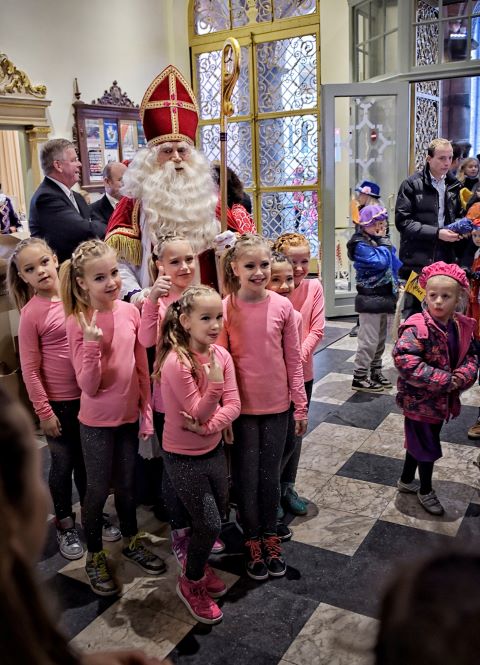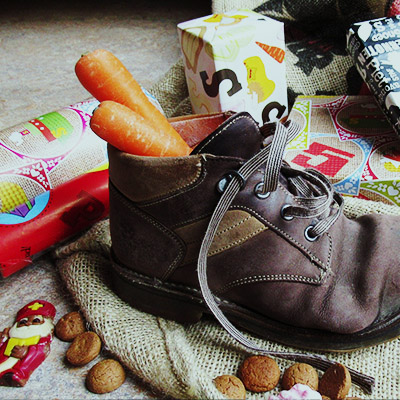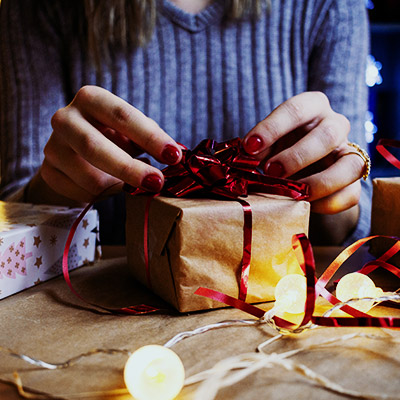
A guide to Dutch gift-giving
Come celebrate Sinterklaas with us

The story

What to buy

What to write

Celebrate

The story
There’s a reason the names ‘Sinterklaas’ and ‘Santa Claus’ sound alike. The Americans copied the idea from Dutch immigrants.
Did you ever wonder why the name ‘Santa Claus’ sounds so similar to ‘Sinterklaas’ – also known as ‘Saint Nicolas’? Were you ever struck by the coincidence that they both love children and deliver presents via the chimney?
It’s obviously not a coincidence at all. Dutch immigrants brought our Sinterklaas tradition to New York in the eighteenth century. Influenced by other cultures’ traditions, our bishop was slowly transformed into Santa Claus.
The Dutch Sinterklaas is based on the bishop Nicolaas of Myra, a Greek saint who lived in what is now Turkey in the third century. He was known for his anonymous gifts to the poor, a tradition that was later turned into presents for kids.
New elements
As far back as the seventeenth century, people celebrated the saint’s birthday by singing songs and putting their shoes next to the chimney for presents. Bad children got – or were threatened with – the rod.
Other elements were added on later. The steamboat that Sinterklaas uses to travel from Spain first occurred in the book Sint Nikolaas en zijn knecht (Saint Nicolas and his servant), written in 1850 by Jan Schenkman, a schoolteacher. Schenkman also introduced other, now well-known elements, like Sinterklaas riding across the roofs on his horse, and his servant, who after a while was named Zwarte Piet (Black Pete). The servant figure bears a striking resemblance to the German Knecht Ruprecht, who had been Sint’s loyal companion since the seventeenth century, as well as Krampus, a demonic figure who, before the days of Sinterklaas, kidnapped children who’d been bad and put them in his sack.
The pictures in the book also cemented the image of the Dutch Sinterklaas: an old man with a long white beard in a red mantle and mitre.
The surprise packages and the accompanying poems are even more recent. A survey held by the Meertens Institute in 1943 showed that almost no one was including those elements in the celebrations back then.
Ded Moroz
In the United States, the Dutch tradition mingled with those of other immigrants, such as the Russian Ded Moroz, or Grandfather Frost, who travels by sleigh to bring people presents towards the end of the year. Then there’s the Finnish tradition Joulupukki, part of the Old Germanic Yuletide festivities. Joulupukki lives on the North Pole. The gift giving tradition was first moved from early December to New Year’s Eve, and then back a bit, to Christmas eve.
American Santa Claus’ look was cemented when the Coca-Cola Company commissioned Haddom Sundblom to draw him for a commercial in 1931. Before this, he had been depicted as both thin and fat, but from that moment on he was forever the blushing, round, friendly man in a red coat, pants, and hat.
The figure of Zwarte Piet has undergone many changes over the past few years. An increasing number of people realised the jolly, dumb character was in fact a racist stereotype.
Because of that, today, the Piet character is no longer covered in black paint; instead, he has soot smudges on his face, which he got from climbing down chimneys to deliver presents.

What to buy
Gift-giving with friends or housemates is usually done Secret Santa-style and you’re often only allowed to spend a few euros on a present. Don’t buy boring things like another chocolate letter, or a bottle of shower gel. Here are some tips on how to do better!
Gift ideas
December calendar. This scratch card advent calendar costs only five euros, but with a little luck (alright, a lot of luck), your gift could end up being worth 100,000 euros. Your housemate has thirty-one days to scratch off, which will hopefully lead to a big payout. Don’t forget to get them to agree to split any big winnings with you.
Check vakantieveilingen.nl. On this website, you can bid in all kinds of different auctions, ranging from perfume, to lovely plants, and day trips. With the right bid at the right time, you might find a great gift for very little money.
Make your own gift, like a personalised board game. Draw a Shoots and Ladders board and write funny assignments and anecdotes in the squares. All you really need is a piece of cardboard, glue, paper, and markers.
Write a coupon for a tasting session that you are organising yourself. A few beers or a couple of different types of wine make for an affordable gift, and you’ll have a nice evening as well!
They often have fun stuff at charity shops, like books, puzzles, pretty drinking glasses, or jewellery, and it all costs next to nothing.
Wrapping
A time-honoured Sinterklaas tradition is to hide your gift in a surprise, which is a special type of gift wrapping where people make a present to look like something else – often connected to the recipient – or include a set of instructions recipients have to follow in order to find their gift.
Don’t have any original ideas? Just do a Google image search for ‘surprise maken’ for endless examples.
It can be a lot of work to make a surprise package though, so often a group will decide to use regular gift wrapping instead. Just make sure everyone’s on the same page, because it would be a bit sad if some people got surprise packages and others didn’t.

What to write
Traditionally, a gift comes with a poem about the recipient, ostensibly written by ‘Sint and Piet’. Here’s how that works.
First, figure out what you want to write about. What has happened to the gift recipient this year? Think of a few themes. You could write a kind of overview. You don’t always have to write a nice, cutesy poem: you can be a bit rude.
Try a rhyming dictionary if you can’t come up with the words yourself. Looking for the ideal word to rhyme with ‘pub’? Rhymezone can help you out: grub, snub, club, or rub.
Make sure to include a few jokes and puns. Nothing is better than making the rest of the group laugh at your poem.
And don’t worry about making the perfect rhymes. Rhyming will help you with the overall structure of the poem, but nobody minds if one or two sentences don’t quite mash.
And it might be a cliché, but that only means it’s true: start on time. You’ll often find fun things to add to a poem if you’ve left it alone for a while.

One way to celebrate
Most student houses will be celebrating Sinterklaas sometime this week. But the students at Huize Maurits went for it two weeks ago. Julia Swaters (21) tells us about their Sinterklaas celebrations.
Huize Maurits houses five men and five women. Their Sinterklaas, which they celebrated as early as November 17 this year, was a big success, as always. ‘With ten people, scheduling is a bitch’, says Julia Swaters. ‘But we have a house meeting every Tuesday, so decided to co-opt it. And since we’re all part of the same household, we didn’t have to change anything from last year because of corona.’
Huize Maurits has a tradition of celebrating Sinterklaas. ‘It’s a whole event; we look forward to it every year.’
They start out by placing a large order at Friet van Piet. ‘Because of Sinterklaas and his Piet. Get it?’ says Julia, laughing. They order from a different place every year, and this year it was the cafeteria’s turn. ‘Everyone dresses up, so there we were in our dresses and suits, eating fries.’
Surprise package
Normally, they’d then exchange gifts accompanied by poems, but this year they went all out: everyone had to wrap the gift in a surprise package. ‘There were a few people who didn’t like that’, says Julia. ‘They didn’t put as much effort into it as others did.’
The student of Dutch language set up a scavenger hunt through the house. She’d hidden little notes with clues about the gifts’ whereabouts. ‘Our budget was twenty euros, so we were able to buy nice things.’
The housemate who’d drawn Julia’s lot hadn’t been quite as creative. While Julia enjoyed her gift of a cupcake tin, a watering can, and a book about herbs, the surprise packaging consisted of nothing more than little waves drawn on coloured paper, supposedly representing her brain.
Embarrassing
But the poems were the highlight of the evening. ‘They can get pretty rude’, Julia says. ‘We all get on each other’s case and dredge up all the embarrassing things that happened to everyone.’ The poems paid special attention to who had slept with whom.
Some people were put on blast for their unacceptable behaviour. ‘I was told that I missed way too many house meetings’, says Julia. ‘Last year, someone was lambasted for not doing enough around the house. He’s been helping out a lot more since then.’
Ad fundum
Finally, they drank. A lot. ‘Everyone has to down a beer whenever a poem tells them to’, says Julia. ‘Like: “We’re so happy to have you here, and now it’s time to drink a beer.”‘ Almost every poem repeats the instructions a few times. One housemate had to drink three beers during a single poem. ‘Not that bad in and of itself, but she was really hungover’, says Julia. ‘She ended up with her head in the toilet.’
They conclude the evening by taking a group shot in their fancy clothes. ‘We put the picture on a Christmas card and send it to everyone in our neighbourhood. Cute, right?’